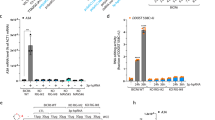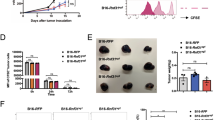Abstract
Viral and pharmacological inducers of protein kinase RNA-activated (PKR)-like ER kinase (PERK) were shown to accelerate the phosphorylation-dependent degradation of the IFNAR1 chain of the Type 1 interferon (IFN) receptor and to limit cell sensitivity to IFN. Here we report that hypoxia can elicit these effects in a PERK-dependent manner. The altered fate of IFNAR1 affected by signaling downstream of PERK depends on phosphorylation of eIF2α (eukaryotic translational initiation factor 2-α) and ensuing activation of p38α kinase. Activators of other eIF2α kinases such as PKR or GCN2 (general control nonrepressed-2) are also capable of eliminating IFNAR1 and blunting IFN responses. Modulation of constitutive PKR activity in human breast cancer cells stabilizes IFNAR1 and sensitizes these cells to IFNAR1-dependent anti-tumorigenic effects. Although downregulation of IFNAR1 and impaired IFNAR1 signaling can be elicited in response to amino-acid deficit, the knockdown of GCN2 in melanoma cells reverses these phenotypes. We propose that, in cancer cells and the tumor microenvironment, activation of diverse eIF2α kinases followed by IFNAR1 downregulation enables multiple cellular components of tumor tissue to evade the direct and indirect anti-tumorigenic effects of Type 1 IFN.
This is a preview of subscription content, access via your institution
Access options
Subscribe to this journal
Receive 50 print issues and online access
$259.00 per year
only $5.18 per issue
Buy this article
- Purchase on Springer Link
- Instant access to full article PDF
Prices may be subject to local taxes which are calculated during checkout




Similar content being viewed by others
Abbreviations
- eIF2α:
-
eukaryotic translation initiation factor 2-α
- GCN2:
-
general control nonrepressed-2
- IFN:
-
interferon
- IFNAR1:
-
interferon-α/β receptor chain 1
- ISR:
-
integrated stress response
- MEF:
-
mouse embryo fibroblast
- PERK:
-
PKR-like ER kinase
- PKR:
-
protein kinase RNA-activated
- STAT:
-
signal transducer and activator of transcription
- shRNA:
-
short hairpin RNA
- TG:
-
thapsigargin.
References
Ye J, Koumenis C . ATF4 an ER stress and hypoxia-inducible transcription factor and its potential role in hypoxia tolerance and tumorigenesis. Curr Mol Med 2009; 9: 411–416.
Ye J, Kumanova M, Hart LS, Sloane K, Zhang H, De Panis DN et al. The GCN2-ATF4 pathway is critical for tumour cell survival and proliferation in response to nutrient deprivation. EMBO J 2010; 29: 2082–2096.
Liu Y, Laszlo C, Liu W, Chen X, Evans SC, Wu S . Regulation of G(1) arrest and apoptosis in hypoxia by PERK and GCN2-mediated eIF2alpha phosphorylation. Neoplasia 2010; 12: 61–68.
Schreiber RD, Old LJ, Smyth MJ . Cancer immunoediting: integrating immunity’s roles in cancer suppression and promotion. Science 2011; 331: 1565–1570.
Moenner M, Pluquet O, Bouchecareilh M, Chevet E . Integrated endoplasmic reticulum stress responses in cancer. Cancer Res 2007; 67: 10631–10634.
Wek RC, Jiang HY, Anthony TG . Coping with stress: eIF2 kinases and translational control. Biochem Soc Trans 2006; 34 (Pt 1): 7–11.
Ron D, Walter P . Signal integration in the endoplasmic reticulum unfolded protein response. Nat Rev Mol Cell Biol 2007; 8: 519–529.
Blalock WL, Bavelloni A, Piazzi M, Faenza I, Cocco L . A role for PKR in hematologic malignancies. J Cell Physiol 2010; 223: 572–591.
Nussbaum JM, Major M, Gunnery S . Transcriptional upregulation of interferon-induced protein kinase, PKR, in breast cancer. Cancer Lett 2003; 196: 207–216.
Kim SH, Forman AP, Mathews MB, Gunnery S . Human breast cancer cells contain elevated levels and activity of the protein kinase, PKR. Oncogene 2000; 19: 3086–3094.
Savinova O, Joshi B, Jagus R . Abnormal levels and minimal activity of the dsRNA-activated protein kinase, PKR, in breast carcinoma cells. Int J Biochem Cell Biol 1999; 31: 175–189.
Bobrovnikova-Marjon E, Grigoriadou C, Pytel D, Zhang F, Ye J, Koumenis C et al. PERK promotes cancer cell proliferation and tumor growth by limiting oxidative DNA damage. Oncogene 2010; 29: 3881–3895.
Koumenis C, Naczki C, Koritzinsky M, Rastani S, Diehl A, Sonenberg N et al. Regulation of protein synthesis by hypoxia via activation of the endoplasmic reticulum kinase PERK and phosphorylation of the translation initiation factor eIF2alpha. Mol Cell Biol 2002; 22: 7405–7416.
Fels DR, Koumenis C . The PERK/eIF2alpha/ATF4 module of the UPR in hypoxia resistance and tumor growth. Cancer Biol Ther 2006; 5: 723–728.
Bhattacharya S, HuangFu WC, Liu J, Veeranki S, Baker DP, Koumenis C et al. Inducible priming phosphorylation promotes ligand-independent degradation of the IFNAR1 chain of type I interferon receptor. J Biol Chem 2010; 285: 2318–2325.
Liu J, HuangFu WC, Kumar KG, Qian J, Casey JP, Hamanaka RB et al. Virus-induced unfolded protein response attenuates antiviral defenses via phosphorylation-dependent degradation of the type I interferon receptor. Cell Host Microbe 2009; 5: 72–83.
Eggermont AM . The role interferon-alpha in malignant melanoma remains to be defined. Eur J Cancer 2001; 37: 2147–2153.
Fidler IJ . The organ microenvironment and cancer metastasis. Differentiation 2002; 70: 498–505.
Platanias LC . Mechanisms of type-I- and type-II-interferon-mediated signalling. Nat Rev Immunol 2005; 5: 375–386.
Hwang SY, Hertzog PJ, Holland KA, Sumarsono SH, Tymms MJ, Hamilton JA et al. A null mutation in the gene encoding a type I interferon receptor component eliminates antiproliferative and antiviral responses to interferons alpha and beta and alters macrophage responses. Proc Natl Acad Sci USA 1995; 92: 11284–11288.
Bhattacharya S, Zheng H, Tzimas C, Carroll M, Baker DP, Fuchs SY . Bcr-abl signals to desensitize chronic myeloid leukemia cells to IFNalpha via accelerating the degradation of its receptor. Blood 2011; 118: 4179–4187.
Kumar KG, Tang W, Ravindranath AK, Clark WA, Croze E, Fuchs SY . SCF(HOS) ubiquitin ligase mediates the ligand-induced down-regulation of the interferon-alpha receptor. EMBO J 2003; 22: 5480–5490.
Liu J, Plotnikov A, Banerjee A, Suresh Kumar KG, Ragimbeau J, Marijanovic Z et al. Ligand-independent pathway that controls stability of interferon alpha receptor. Biochem Biophys Res Commun 2008; 367: 388–393.
Zheng H, Qian J, Carbone CJ, Leu NA, Baker DP, Fuchs SY . Vascular endothelial growth factor-induced elimination of the type 1 interferon receptor is required for efficient angiogenesis. Blood 2011; 118: 4003–4006.
Zheng H, Qian J, Varghese B, Baker DP, Fuchs S . Ligand-stimulated downregulation of the alpha interferon receptor: role of protein kinase D2. Mol Cell Biol 2011; 31: 710–720.
Qian J, Zheng H, Huangfu WC, Liu J, Carbone CJ, Leu NA et al. Pathogen recognition receptor signaling accelerates phosphorylation-dependent degradation of IFNAR1. PLoS Pathog 2011; 7: e1002065.
Bhattacharya S, Qian J, Tzimas C, Baker DP, Koumenis C, Diehl JA et al. Role of p38 protein kinase in the ligand-independent ubiquitination and down-regulation of the IFNAR1 chain of type I interferon receptor. J Biol Chem 2011; 286: 22069–22076.
Liu J, Carvalho LP, Bhattacharya S, Carbone CJ, Kumar KG, NA Leu et al. Mammalian casein kinase 1alpha and its leishmanial ortholog regulate stability of IFNAR1 and type I interferon signaling. Mol Cell Biol 2009; 29: 6401–6412.
Huangfu WC, Fuchs SY . Ubiquitination-dependent regulation of signaling receptors in cancer. Genes Cancer 2010; 1: 725–734.
Diehl JA, Fuchs SY, Koumenis C . The cell biology of the unfolded protein response. Gastroenterology 2011; 141: 38–41 e1-2.
Bobrovnikova-Marjon E, Pytel D, Riese MJ, Vaites LP, Singh N, Koretzky GA et al. PERK utilizes intrinsic lipid kinase activity to generate phosphatidic acid, mediate AKT activation and promote adipocyte differentiation. Mol Cell Biol 2012; 32: 2268–2278.
Hamanaka RB, Bobrovnikova-Marjon E, Ji X, Liebhaber SA, Diehl JA . PERK-dependent regulation of IAP translation during ER stress. Oncogene 2009; 28: 910–920.
Blais JD, Filipenko V, Bi M, Harding HP, Ron D, Koumenis C et al. Activating transcription factor 4 is translationally regulated by hypoxic stress. Mol Cell Biol 2004; 24: 7469–7482.
Huangfu WC, Qian J, Liu C, Liu J, Lokshin AE, Baker DP et al. Inflammatory signaling compromises cell responses to interferon alpha. Oncogene 2012; 31: 161–172.
Pindel A, Sadler A . The role of protein kinase R in the interferon response. J Interferon Cytokine Res 2011; 31: 59–70.
Williams BR . PKR; a sentinel kinase for cellular stress. Oncogene 1999; 18: 6112–6120.
Pfeffer LM, Wang E, Tamm I . Interferon effects on microfilament organization, cellular fibronectin distribution, and cell motility in human fibroblasts. J Cell Biol 1980; 85: 9–17.
Brassard DL, Grace MJ, Bordens RW . Interferon-alpha as an immunotherapeutic protein. J Leukoc Biol 2002; 71: 565–581.
Parmar S, Platanias LC . Interferons: mechanisms of action and clinical applications. Curr Opin Oncol 2003; 15: 431–439.
Li Y, Srivastava KK, Platanias LC . Mechanisms of type I interferon signaling in normal and malignant cells. Arch Immunol Ther Exp (Warsz) 2004; 52: 156–163.
Folkman J, Ingber D . Inhibition of angiogenesis. Semin Cancer Biol 1992; 3: 89–96.
Borovski T, De Sousa EMF, Vermeulen L, Medema JP . Cancer stem cell niche: the place to be. Cancer Res 2011; 71: 634–639.
Dunn GP, Koebel CM, Schreiber RD . Interferons, immunity and cancer immunoediting. Nat Rev Immunol 2006; 6: 836–848.
Diamond MS, Kinder M, Matsushita H, Mashayekhi M, Dunn GP, Archambault JM et al. Type I interferon is selectively required by dendritic cells for immune rejection of tumors. J Exp Med 2011; 208: 1989–2003.
Fuertes MB, Kacha AK, Kline J, Woo SR, Kranz DM, Murphy KM et al. Host type I IFN signals are required for antitumor CD8+ T cell responses through CD8{alpha}+ dendritic cells. J Exp Med 2011; 208: 2005–2016.
Noman MZ, Messai Y, Carre T, Akalay I, Meron M, Janji B et al. Microenvironmental hypoxia orchestrating the cell stroma cross talk, tumor progression and antitumor response. Crit Rev Immunol 2011; 31: 357–377.
Tang W, Li Y, Yu D, Thomas-Tikhonenko A, Spiegelman VS, Fuchs SY . Targeting beta-transducin repeat-containing protein E3 ubiquitin ligase augments the effects of antitumor drugs on breast cancer cells. Cancer Res 2005; 65: 1904–1908.
Soldatenkov VA, Dritschilo A, Ronai Z, Fuchs SY . Inhibition of homologue of Slimb (HOS) function sensitizes human melanoma cells for apoptosis. Cancer Res 1999; 59: 5085–5088.
Kumar KG, Krolewski JJ, Fuchs SY . Phosphorylation and specific ubiquitin acceptor sites are required for ubiquitination and degradation of the IFNAR1 subunit of type I interferon receptor. J Biol Chem 2004; 279: 46614–46620.
Acknowledgements
We thank M Herlyn, R Kaufman, A Koromilas, A Nebreda, D Ron and Z Ronai for reagents, Dr Yong Zhang for technical help, and the members of Fuchs, Diehl and Koumenis labs for discussion. The support to SB from the ‘Training in Tumor Virology’ Grant 2-T32-CA-557726-06 is greatly appreciated. This work was supported by the NIH Grants CA92900 and CA142425 (to SYF), CA94214 (to CK), CA104838 (to JAD) and by a grant with the Pennsylvania Department of Health (to JAD, CK, and SYF). The Department specifically disclaims responsibility for any analyses, interpretation or conclusions.
Author information
Authors and Affiliations
Corresponding author
Ethics declarations
Competing interests
Dr DP Baker is an employee of BiogenIDEC Inc. and owns stock of this company. The other authors declare no conflict of interest.
Additional information
Supplementary Information accompanies the paper on the Oncogene website
Supplementary information
Rights and permissions
About this article
Cite this article
Bhattacharya, S., HuangFu, WC., Dong, G. et al. Anti-tumorigenic effects of Type 1 interferon are subdued by integrated stress responses. Oncogene 32, 4214–4221 (2013). https://doi.org/10.1038/onc.2012.439
Received:
Revised:
Accepted:
Published:
Issue Date:
DOI: https://doi.org/10.1038/onc.2012.439
Keywords
This article is cited by
-
Direct and indirect effects of IFN-α2b in malignancy treatment: not only an archer but also an arrow
Biomarker Research (2022)
-
Immune suppressive activity of myeloid-derived suppressor cells in cancer requires inactivation of the type I interferon pathway
Nature Communications (2021)
-
Down-Regulation of ID2-AS1 Alleviates the Neuronal Injury Induced by 1-Methy1-4-Phenylpyridinium in Human Neuroblastoma Cell Line SH-SY5Y Cells Through Regulating miR-199a-5p/IFNAR1/JAK2/STAT1 Axis
Neurochemical Research (2021)
-
An optimized retinoic acid-inducible gene I agonist M8 induces immunogenic cell death markers in human cancer cells and dendritic cell activation
Cancer Immunology, Immunotherapy (2019)
-
A PERK–miR-211 axis suppresses circadian regulators and protein synthesis to promote cancer cell survival
Nature Cell Biology (2018)



